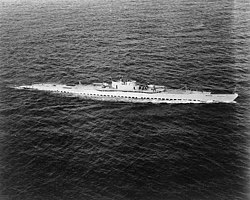USS Nautilus (SS-168)
|
||||||||||||||
|
||||||||||||||
|
||||||||||||||
|
||||||||||||||
|
||||||||||||||
The USS Nautilus (ID: SS-168) was the fifth ship in the United States Navy to bear this name . It was a submarine that was laid down at the Mare Island naval shipyard in 1927 and put into service in 1930. She was one of the "V-Boats", a group of large submarines, which, inspired by the German U-Cruisers , had been designed for long-range oceanic undertakings. The sister ship of the Nautilus was the USS Narwhal , other ships in the group were the USS Barracuda , USS Bass , USS Bonita , USS Argonaut , USS Dolphin , USS Cachalot and USS Cuttlefish . The Nautilus was numbered V-6 (SF-9) when it was commissioned , and the name was changed to Nautilus in 1931.
The Nautilus was stationed in Pearl Harbor during the 1930s , where she was the flagship of a submarine division and regularly participated in fleet exercises and training missions. In July 1941, the boat was modernized at its shipyard, including new diesel engines, air conditioning and improved radio equipment. The overhaul lasted until the spring of 1942, so that the boat was not in the home port during the attack on Pearl Harbor .
After the overhaul, the boat took part in the Pacific War. On the very first patrol, the boat took part in the Battle of Midway , where it was the only American submarine to be shot. For a long time it was assumed that she sank the already battered Japanese aircraft carrier Kaga . Witness statements by Japanese survivors after the war confirmed that two torpedoes missed the carrier and the third was a dud. Two more torpedoes, shot down at a ship identified as a battleship , also missed their target. The commander of the Nautilus received the Navy Cross for his services during the battle . After supplementing Stock on the Midway sat Nautilus continued the patrol, where they damaged a Japanese destroyer and an oil tanker and the Japanese destroyer Yamakaze sank before it by a damage to water bombing returned to Pearl Harbor.
The boat's second patrol led to the Makin Islands. The Nautilus and Argonaut were carrying a special marine unit for a diversionary attack. The two submarines also gave the troops, who picked them up again two days later, support fire, the Nautilus sank a patrol boat and a launch.
The next patrol took the boat into Japanese waters. Despite numerous problems due to bad weather and technical problems, the Nautilus sank three Japanese freighters and, with the on-board guns, three sampans , a total of over 12,000 GRT . The ship continued to operate for a few days, although it left a trail of oil on the surface of the water after another depth charge.
After the necessary repairs in Pearl Harbor, the patrol first led the Nautilus to the Solomon Islands , where the boat evacuated 26 adults and three children on December 31, 1942 and January 1, 1943. Before setting it down in Brisbane , Australia on February 4, the Nautilus sank a Japanese freighter and damaged another, as well as a destroyer and a tanker. The Nautilus drove from Brisbane to Pearl Harbor and continued to Alaska after five days . There she trained an army scout unit in amphibious landings. 109 men of this unit dropped the Nautilus five hours before the main landing of the US troops on the island of Attu .
After an overhaul in the summer of 1943, the Nautilus' next mission was a reconnaissance mission, during which it photographed the coasts of several islands, including Tarawa . The next mission took the Nautilus back to Tarawa, again as a means of transport for a special unit. Although the Nautilus was mistakenly shot at and slightly damaged by the American destroyer USS Ringgold (DD-500) on the way , she landed the 78 men, US Marines and an Australian scout safely and confirmed the success of the mission by shelling the Japanese bunker with their on-board cannons.
After another patrol, on which the Nautilus sank another Japanese freighter, a series of missions followed in which the transport capacity of the Nautilus was used for special orders. The boat transported ammunition and other supplies to local resistance groups against the Japanese, and evacuated refugees on the return voyages. On the thirteenth patrol voyage, the Nautilus also fulfilled an unusual mission, namely the destruction of the USS Darter , which ran aground on a reef and could not be freed despite all efforts. The Darter's crew had already been taken over by the USS Dace . Attempts by both the Dace and the USS Rock to destroy the tethered boat had failed, however, as torpedoes hit the reef and not the boat. The Nautilus deployed its 6-inch guns and scored 55 hits that turned the darters into a wreck.
After the fourteenth patrol, which the Nautilus ended on January 30, 1945 in Darwin , the US Navy moved the boat to Philadelphia , where it was decommissioned on June 30, 1945. After being deleted from the naval register on July 23, the boat was sold for scrapping.
The Nautilus received 14 Battle Stars and the Presidential Unit Citation for its use in World War II.
